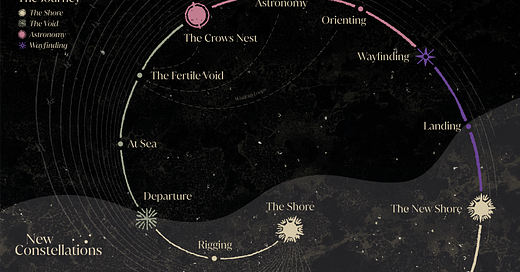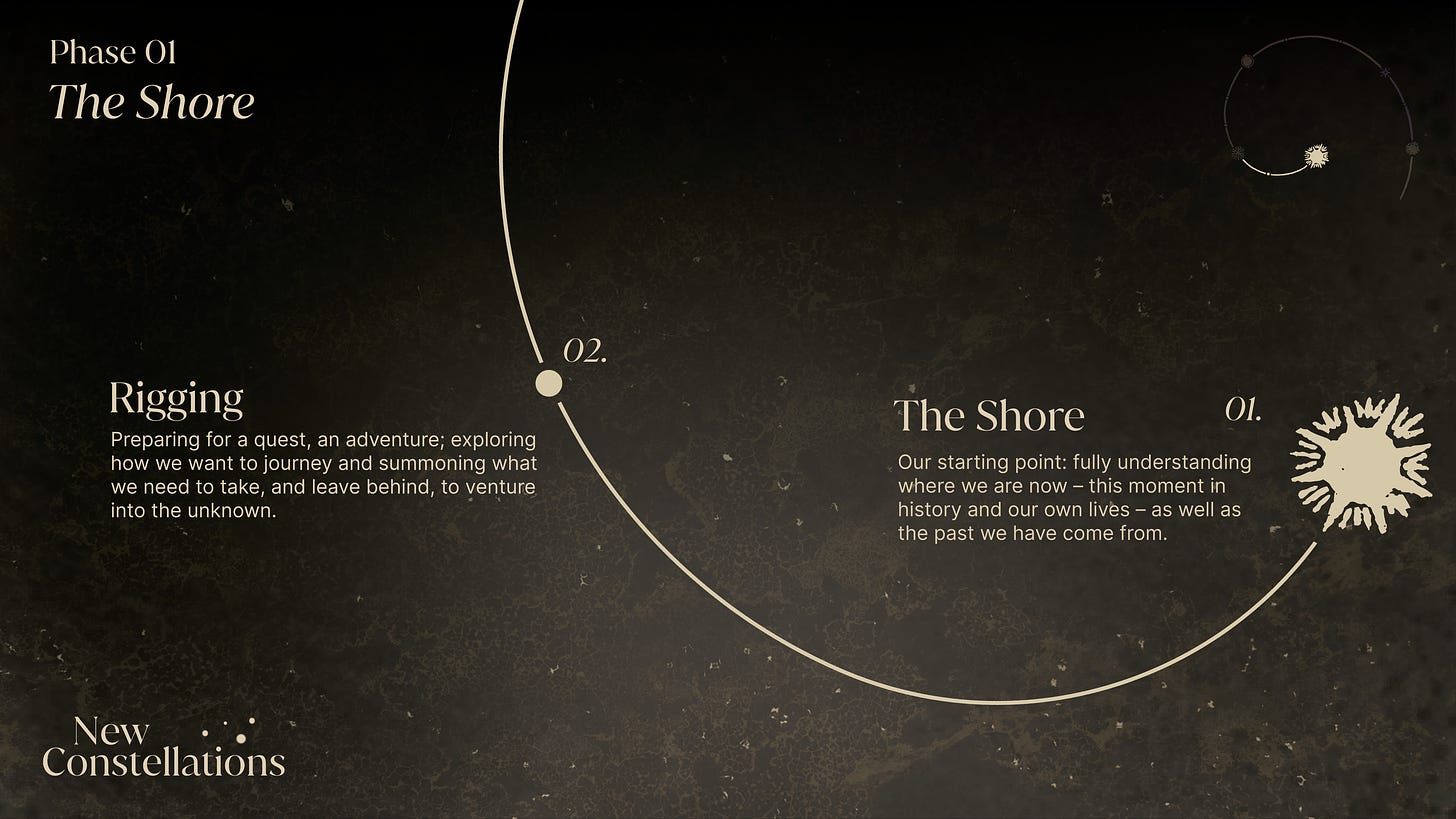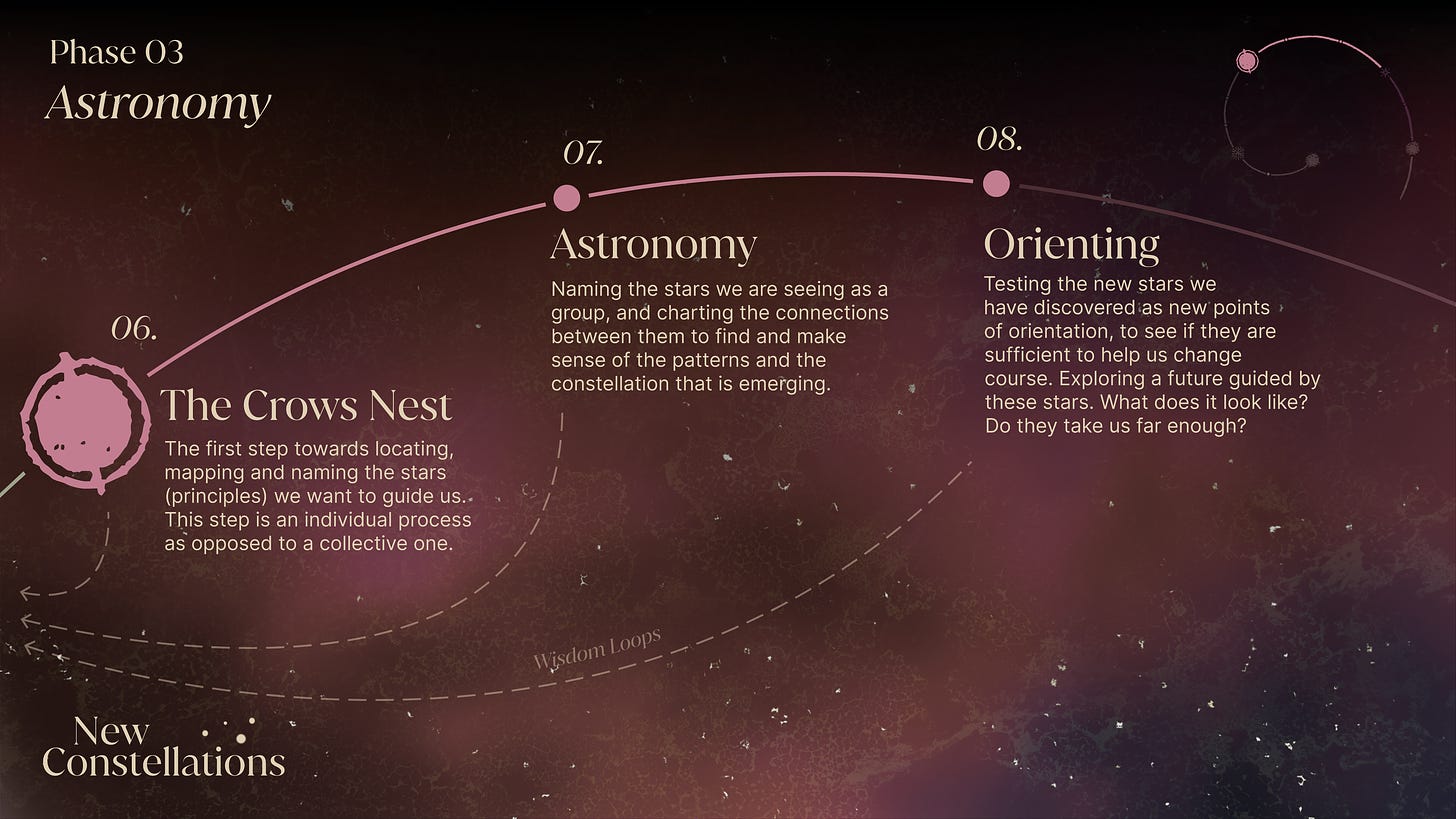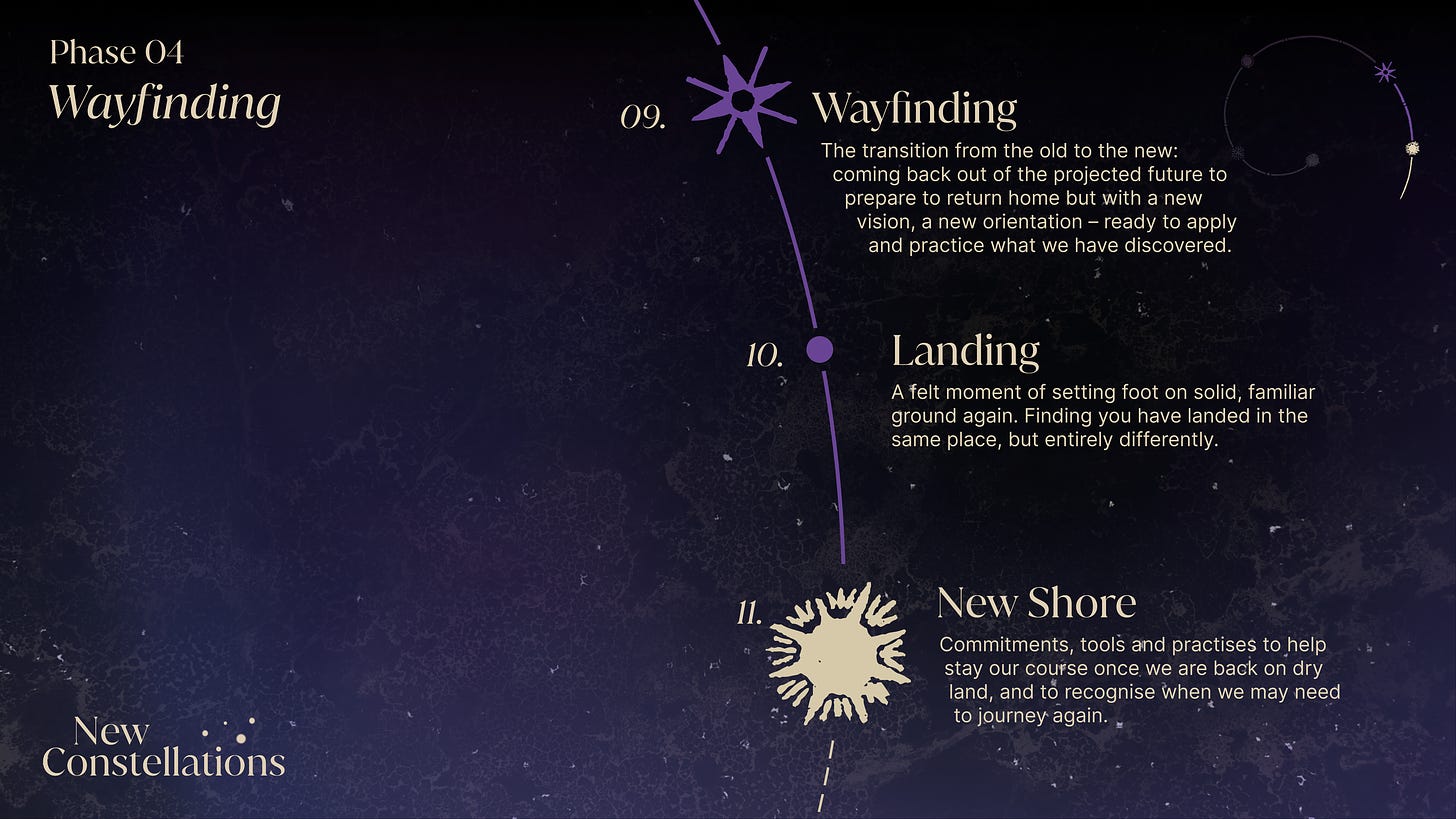The Journey
New Constellations was born out of the recognition that we are living through a time of great upheaval, and out of the desire to create spaces in which people can reflect on what we are living through and consider how we should respond.
As I reflected in the last blog, “The scale of the challenge - of designing new ways in which we can live and work together that generate wellbeing, grow capabilities across communities and embed a reciprocally thriving relationship with nature and other species - means that we have to look beyond tinkering with existing methods and experiment with new ways and means of doing things.” New Constellations is our small contribution to that exploration.
Over the past 18 months, we’ve been developing a process that we call the journey (drawing on the archetypal structure of an Odyssey), an immersive experience that we run for groups of about 15-20 people to help people examine the reality of the status quo, become more comfortable in uncertainty, open up to new possibilities and discover bold new visions for the future.
The journey begins in the world as it is, projects backwards into the past and then forwards into the world as it could be. It then returns to the present moment to explore the path of transition between where we are and where we need to be, at the levels of self, group, and system.
In our work, we use the idea of the stars because, for millennia, human beings have used the stars for navigation, as guide points to head towards across the vast and uncertain seas. We can dream of a different future but we need some guideposts to reach it. The stars give us direction and something to head towards.
Imagine for a moment that you are out at sea, on a boat or craft, navigating towards certain stars. When a boat points towards a star, it sets its course, the direction it will take and, therefore, its destination. The stars for us in this journey are our guideposts or directions which, if we head towards them, will reorient our ways of living, working and connecting. If we shift our focus and direction towards a different star, we will change where we end up – as individuals, as communities, as a place.
The visualisation above depicts the stages of the journey. We meet people on the shore and take them on an imaginary journey in a boat out to sea. Unlike the colonial journey, in which empire builders looked to build new utopias on virgin terrain – the act of ‘terraforming’ as Amitav Gosh articulates brilliantly in The Nutmeg’s Curse – this journey begins and ends on our own shore. Our task is to return from the open seas and to set to work back home.
The Shore and our Rigging
The shore is the here and now, all that is around us, our past and present enmeshed. A shore that has emerged from the accretion of millions of actions and decisions and joys and traumas of the past. A shore that, to some extent, informs who we are and how we act.
Before we can consider the future, we need to ground ourselves in the present and reflect on how it has come to be. We find things in the past that we have forgotten and need to reclaim and rekindle. We also find roots of harm we are inflicting on each other and on the earth. We need space to reflect on this. When I look back, I feel pride when I think of those I love and places that are special to me. I also feel regret, anger, guilt, and grief in the past – for example, from the human, environmental and ideological legacy of colonialism – borne out of its foundational belief in human beings and the planet as a resource to exploit. I also feel a yearning and nostalgia for ways of life that are no longer – a simpler, deeper experience of place and community and of connection to tradition and ritual that are of these lands and connect me to it. It helps me understand that the past is seeped deep within me, in ways that are visible and invisible to me.
Increasingly, we also need space to process the present. Our hearts and brains are full. We strain to comprehend the intersection of longer-term existential threats such as climate change with those, like the conflicts in Ukraine and Yemen, that are happening right now, barrelling violently into our newsfeeds hour by hour.
If we want to move forwards together and prevent what faces us from tearing us apart, then we need space to listen to each other and deepen our compassion and understanding. If we choose to, we can help each other see the reality of our present moment and discern what to take with us and what to leave behind in the process of transformation. We can hold and support each other in the realisation that we have no choice, we must move beyond our current paradigms, and we will only survive if we do so together.
We think of rigging as the act of preparing for a journey. The equivalent of checking the masts and sails of a ship before it departs. Preparing our rigging summons up what we need to venture into the vast unknown. We must confront areas of denial and the false stories that we tell ourselves. We must throw off limiting beliefs that inhibit our confidence to undertake a process of exploration.
Once out at sea, we will miss home and the comforts of all that is familiar. We know we will need something to bolster our courage and determination to go further than feels comfortable. So, before we depart, we ask ourselves about the purpose of our journey, who we are journeying for and with and who we are accountable to.
Departure, At Sea and The Fertile Void
When it is time to depart, we imagine ourselves standing in the shallows, water lapping at our feet. As we take one foot off the shore and climb into the boat, we know we are entering a different material reality. We feel our bodies leave the security of solid ground. We might have second thoughts on whether we really want to leave. Of whether it’s necessary to turn away from the ways we do things, the way we are.
In ‘Down to Earth’, Bruno Latour describes how each one of us has now lost our ground, our land, our previous reality. None of us can cling to what was because it no longer exists. So, we either fight and drown at sea or hold hands, take the leap and help each other come down to earth.
“This is why it is urgent to… define politics as what leads toward the Earth and not toward the global or the national. Belonging to a territory is the phenomenon most in need of rethinking and careful redescription; learning new ways to inhabit the Earth is our biggest challenge. Bringing us down to earth is the task of politics today.”
Bruno Latour, Down to Earth
We need skills to navigate an era of radical uncertainty, what John Seely Brown calls the ‘white water world’. Our first reactions may be to grasp, to cry out, to try and regain stability but instead we need to find states of flow.
As the boat pushes out, we find ourselves at sea, an expanse of blue all around. We feel confused and disorientated by the unfathomably deep, broiling waters beneath us. In our daily experiences of the volatile world, we can often feel at sea. I am privileged, for most of my life I have lived on solid ground. But I know many people haven’t had that luxury.
We help people quieten and turn inwards, to imagine the waters supporting them. To lie, calm and outstretched until we have that feeling of the boundaries between our bodies and the water dissolve. Perhaps we feel closer to death, free of the weight of the present moment, of a lifetime. We can find feelings of beauty, of being unencumbered, of acceptance, of letting go.
We have slipped into InnSæi, the sea within. This is a beautiful Icelandic word for the space of intuition, one my friend and constant inspiration Hrund Gunnsteinsdottir introduced me to through her research on intuition, a story she tells in her film of the same name.
It is a state in which we can wonder, enquire, and feel but don’t yet need to make sense. A state which enables us to be and think differently. It is a process of unbecoming.
In New Constellations, we draw on the concept of the fertile void (with thanks to Kate Raworth for introducing us to Paul Goodman’s remark that “Confusion is the state of promise, the fertile void where surprise is possible again.”)
In the fertile void, glimmers of hope and possibility flicker. It is all too easy to think that the future we yearn for is a chimaera, a naïve fantasy. But it is already emerging all around us, in the work and practice of people who are not waiting for the world to catch up with what we need to do, who are getting on with it. I find inspiration and comfort knowing that so many people are already doing this work.
Crow’s Nest, Astronomy and Orienting
Having left the shore and found our sea legs, it's time to begin discerning the new stars that might guide us toward a better future. The stars for us in this journey are our guideposts or directions which, if we head towards them, will reorient our ways of living, working and connecting. If we shift our focus and direction towards a different set of stars, we will change where we end up, as individuals, as communities, as a place. And it doesn’t always take a huge shift to reach a dramatically different destination. Imagine a huge tanker out to sea. If it changes course by even a few degrees, it will end up somewhere totally different.
An earlier blog explored some of the glimmers of hope and possibility that might show us the way ahead. When I look at the work that inspires me (some of it reflected in our audio encounters), I see commonalities between the values and principles that animate it. These examples understand and situate themselves within the system of life and the transformation that is needed to keep it in balance; they regenerate; they distribute; they connect; they build relationships and reciprocity; they value lived and learned experience; they cross the silos of society, markets and the state; they contribute to the collaborative commons and they take responsibility for future generations. They are not just about ideas and dreams but rooting those dreams in the urgency of now and the practical things that make ideas reality.
These principles are like stars. They are useful alone but, connected and taken together, we can use them to design forms of work, play, learning and caring for each other and the natural world. So, our task is to find the stars, explore their relationship with one another and to conjure up concrete visions of the future guided by these constellations.
“I believe that all organising is science fiction - that we are shaping the future we long for and have not yet experienced.”
adrienne maree brown, Pleasure Activism: The Politics of Feeling Good.
To start to discern the stars, we climb up to the crow’s nest alone, giving ourselves time to adjust to our night vision. In solitude, we can see which stars we feel most drawn to and feel magnetic.
Following this experience of solitary reflection, we return to deck to tell each other stories of what we have seen. We go through a process of astronomy together – the generative and more challenging experience of working with others.
Humans are storytellers and meaning-makers – for millennia, we’ve seen pictures in the sky and told stories about the constellations. Stories that vary from culture to culture and seep deeply into our view of existence and ourselves. In this journey, as we begin to see what the world looks if we make decisions and take actions based on these new stars, a picture and story which gives us a felt sense of a different world, a future we can then call in and celebrate.
After the sun has fully risen, and our astronomy is done, we return to the deck to test our discoveries in the cold light of day: a first attempt at orienting towards them. Do these new constellations work as guiding principles? Do they lead us in a better direction, towards the flourishing future we know can emerge? What are the risks and limitations that lie within them? What are the false stories they might tell us?
If they are inadequate guides, we can go back out into the night once again, into the void, to find more distant stars, perhaps stars long forgotten that we need to bring back into our constellations too.
Wayfinding
When our astronomy is complete and our stars are mapped, we prepare to return to the hard knocks of the real world. Returning to shore will be hard. When I have undertaken similar journeys, I can return feeling displaced from the world around me. I can feel bereft of the hope I experienced, of the feelings of possibility, of the company of my crew. I sometimes doubt whether it is all possible after all.
So preparing to return is as important as preparing our rigging before we set out on a journey. This time, it’s about equipping ourselves with practices and tools that can help us reorient our approaches and behaviour towards the stars we have found. Tools that can help us stay the course and prepare us for the inevitable opposition, challenges, and setbacks we will face. Practices that allow us to slip back into the sea within and reconnect to the felt experiences we had, the things we discerned and the connections we made to others. We will need help and community to sustain commitment, build resilience and grit. (It’s worth mentioning the Burkana Two Loop and the Three Horizons models as our overarching frameworks here. Sophy Banks’s work on healthy human cultures has also been inspirational to us recently).
When the moment to return home arises, we experience the heaviness and loss of the end of a journey and the relief and longing for home. But we must be under no illusion that, unless we return and start the work, it will be a dream. So, once again, we must leave this place, these waters.
Our journey gives us a heightened clarity and conviction that transformation is required for us to have any hope of meeting the challenges of our time. And that all of us are required to do our part. So the decision to return also releases a sense of rising agency, of camaraderie, of bravery, of gritty possibility. Before heading homewards, we take a moment to reconnect with who we have been and who we want to become, to the anticipation of landing and to all that we will find when we return.
Landing
The shore is within our sights once again, we are heading towards familiar shapes and hues. As we near the shore it comes into focus. The details of daily life return. As the boat nears the shore, we prepare to set foot on solid ground once again.
We feel the hull of the boat touch and then bank on the surface of the earth, a gradual shudder. We have landed. Back in the place we set off from and yet, somehow, we have landed differently to how we set sail. Though familiar, we see now our shore through a different lens.
We return with a heightened understanding of ourselves, of our own responsibilities, with a greater appreciation for and understanding of others. And, hopefully, with conviction to follow new constellations and to tell others of our journey out to sea.
Of course, we know that the journey is never over. In an ever-changing world, we too must be in a constant cycle. At some point, staying our course will become too hard, we will become bogged down, we will realise that the constellation we found gets us so far but not far enough and so we will need to journey out to sea again. But this time, whenever we need to, we can draw on our voyage of imagination, return to it at night, tucked up in our beds through the deeper connection we have established to the sea within us all.
Ultimately, our constellations cannot live outside us – a remote point of navigation in the sky. They must live within us, guiding us, fortifying us, empowering us. So that instead of being cartographers, we follow the lead of Polynesian wayfarers who navigated thousands of miles through a deep connection with the sky and seas around them. As we begin to tell the story of what we have seen and discovered and how it will guide us, we can internalise our experience, and bring the constellation within.
New Constellations hold journeys with communities of place, with people working within specific systems, with organisations and companies, and with thinkers, makers and doers at the cutting edge of their field. We also host experiences as part of wider events, festivals and retreats. If you or your organisation would like to explore journeying with us, please get in touch.








